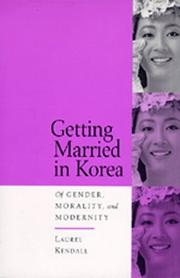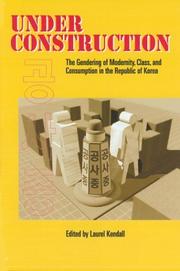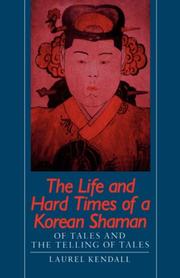| Listing 1 - 10 of 23 | << page >> |
Sort by
|

ISBN: 0520201981 0520202007 Year: 1996 Publisher: Berkeley University of California press
Abstract | Keywords | Export | Availability | Bookmark
 Loading...
Loading...Choose an application
- Reference Manager
- EndNote
- RefWorks (Direct export to RefWorks)
This work explores what it means to be modern and what it means to be Korean in a culture where courtship and marriage are often the crucible in which notions of gender and class are cast and recast. Touching on a number of important issues--identity, romantic love, women's work, marriage negotiations, and wedding ceremonies--Laurel Kendall gives us a new appreciation for how Koreans have adapted this pivotal social practice to the astounding changes of the past century.
Marriage customs and rites --- -Wedding etiquette --- -Sex role --- -Gender identity --- -Social classes --- -Ceremonial exchange --- -K9325.10 --- K9327 --- Gift exchange --- Exchange --- Rites and ceremonies --- Class distinction --- Classes, Social --- Rank --- Caste --- Estates (Social orders) --- Social status --- Class consciousness --- Classism --- Social stratification --- Sex identity (Gender identity) --- Sexual identity (Gender identity) --- Identity (Psychology) --- Sex (Psychology) --- Queer theory --- Gender role --- Sex differences (Psychology) --- Social role --- Gender expression --- Sexism --- Etiquette --- Bridal customs --- Betrothal --- Manners and customs --- Weddings --- Korea --- Korea: Communities, social classes and groups -- family -- marriage and divorce --- Korea: Communities, social classes and groups -- gender roles, women, feminism, men --- Social conditions. --- Wedding etiquette --- Sex role --- Gender identity --- Social classes --- Ceremonial exchange --- Mariage --- Savoir-vivre --- Rôle selon le sexe --- Identité sexuelle --- Classes sociales --- Echange cérémoniel --- Rites et cérémonies --- Corée --- Conditions sociales --- K9325.10 --- Gender roles --- Gendered role --- Gendered roles --- Role, Gender --- Role, Gendered --- Role, Sex --- Roles, Gender --- Roles, Gendered --- Roles, Sex --- Sex roles --- Gender dysphoria

ISBN: 0824824075 0824824881 9780824824075 9780824824884 Year: 2002 Publisher: Honolulu University of Hawaii press
Abstract | Keywords | Export | Availability | Bookmark
 Loading...
Loading...Choose an application
- Reference Manager
- EndNote
- RefWorks (Direct export to RefWorks)
Sex role --- Masculinity --- Femininity --- Social classes --- Women --- Social conditions --- -Masculinity --- -Femininity --- -Social classes --- -Woman --- -K9327 --- K9310 --- K9300 --- -Human females --- Wimmin --- Woman --- Womon --- Womyn --- Females --- Human beings --- Class distinction --- Classes, Social --- Rank --- Caste --- Estates (Social orders) --- Social status --- Class consciousness --- Classism --- Social stratification --- Femininity (Psychology) --- Sex (Psychology) --- Masculinity (Psychology) --- Men --- Gender role --- Sex differences (Psychology) --- Social role --- Gender expression --- Sexism --- Korea (South) --- -Korea: Communities, social classes and groups -- gender roles, women, feminism, men --- Korea: Society, social psychology and social-anthropological phenomena (South) Korea --- Korea: Social sciences -- general, social and cultural history --- -Korea (South) --- K9327 --- Korea: Communities, social classes and groups -- gender roles, women, feminism, men --- Sex role - Korea (South) --- Masculinity - Korea (South) --- Femininity - Korea (South) --- Social classes - Korea (South) --- Women - Korea (South) - Social conditions

ISBN: 0824811453 9780824811457 0824811364 9780824811365 Year: 1988 Publisher: Honolulu : University of Hawaii Press,
Abstract | Keywords | Export | Availability | Bookmark
 Loading...
Loading...Choose an application
- Reference Manager
- EndNote
- RefWorks (Direct export to RefWorks)
Antropoloog Laurel Kendall vertelt in dit fictieve boek het verhaal van een Koreaanse sjamaan maar verwerkt in dit werk wel allerlei info die helemaal niet verzonnen is maar wel degelijk overeenstemt met de realiteit. Noem het dus een kennismaking met het Koreaanse sjamanisme in de vorm van een fictieverhaal.
Women shamans --- Women --- Social conditions. --- Asien. --- Shamans --- Women shamans - Korea (South) --- Women - Korea (South) - Social conditions. --- Social conditions

ISBN: 0520916786 0585047669 9780520916784 9780585047669 0520201981 0520202007 9780520201989 0520201981 9780520202009 0520202007 Year: 1996 Publisher: Berkeley, Calif. ; London : University of California Press,
Abstract | Keywords | Export | Availability | Bookmark
 Loading...
Loading...Choose an application
- Reference Manager
- EndNote
- RefWorks (Direct export to RefWorks)
This work explores what it means to be modern and what it means to be Korean in a culture where courtship and marriage are often the crucible in which notions of gender and class are cast and recast. Touching on a number of important issues--identity, romantic love, women's work, marriage negotiations, and wedding ceremonies--Laurel Kendall gives us a new appreciation for how Koreans have adapted this pivotal social practice to the astounding changes of the past century. Kendall attended her first Korean wedding in 1970, soon after she arrived in the country with the Peace Corps. Years later, as a seasoned anthropologist, she began interviewing couples, matchmakers, and proprietors of wedding halls. She consulted etiquette handbooks and women's magazines and analyzed cartoons, photographs, and weddings themselves. The result is an engaging account of how marriage matches are made, how families proceed through the rites, how they finance ceremonies and elaborate exchanges of ritual goods, and how these practices are integral to the construction of adult identities and notions of ideal women and men.--From publisher description.
Marriage customs and rites --- Wedding etiquette --- Sex role --- Gender identity --- Social classes --- Ceremonial exchange --- Manners & Customs --- Anthropology --- Social Sciences --- Gift exchange --- Exchange --- Rites and ceremonies --- Etiquette --- Sex identity (Gender identity) --- Sexual identity (Gender identity) --- Identity (Psychology) --- Sex (Psychology) --- Queer theory --- Gender role --- Sex differences (Psychology) --- Social role --- Gender expression --- Sexism --- Korea --- Social conditions. --- Gender roles --- Gendered role --- Gendered roles --- Role, Gender --- Role, Gendered --- Role, Sex --- Roles, Gender --- Roles, Gendered --- Roles, Sex --- Sex roles --- Gender dysphoria
Book
ISBN: 9780824833435 9780824833985 Year: 2009 Publisher: Honolulu University of Hawaii press
Abstract | Keywords | Export | Availability | Bookmark
 Loading...
Loading...Choose an application
- Reference Manager
- EndNote
- RefWorks (Direct export to RefWorks)
Shamanism --- Korea --- Civilization --- Shamanistic influences. --- Religion.
Book
ISBN: 0520970713 0520420691 Year: 2021 Publisher: Oakland, California : University of California Press,
Abstract | Keywords | Export | Availability | Bookmark
 Loading...
Loading...Choose an application
- Reference Manager
- EndNote
- RefWorks (Direct export to RefWorks)
Paintings, statues, and masks—like the bodies of shamans and spirit mediums—give material form and presence to otherwise invisible entities, and sometimes these objects are understood to be enlivened, agentive on their own terms. This book explores how magical images are expected to work with the shamans and spirit mediums who tend and use them in contemporary South Korea, Vietnam, Myanmar, Bali, and elsewhere in Asia. It considers how such things are fabricated, marketed, cared for, disposed of, and sometimes transformed into art-market commodities and museum artifacts.
Commodification. --- Idols and images --- Religious art --- Religious articles
Book
ISBN: 9780824844837 Year: 2022 Publisher: Honolulu
Abstract | Keywords | Export | Availability | Bookmark
 Loading...
Loading...Choose an application
- Reference Manager
- EndNote
- RefWorks (Direct export to RefWorks)
Book
ISBN: 9780824845858 Year: 2021 Publisher: Honolulu
Abstract | Keywords | Export | Availability | Bookmark
 Loading...
Loading...Choose an application
- Reference Manager
- EndNote
- RefWorks (Direct export to RefWorks)
Book
ISBN: 9780824860899 Year: 2009 Publisher: Honolulu
Abstract | Keywords | Export | Availability | Bookmark
 Loading...
Loading...Choose an application
- Reference Manager
- EndNote
- RefWorks (Direct export to RefWorks)
Book
ISBN: 0912966912 Year: 1987 Publisher: Berkeley University of California press
Abstract | Keywords | Export | Availability | Bookmark
 Loading...
Loading...Choose an application
- Reference Manager
- EndNote
- RefWorks (Direct export to RefWorks)
| Listing 1 - 10 of 23 | << page >> |
Sort by
|

 Search
Search Feedback
Feedback About UniCat
About UniCat  Help
Help News
News